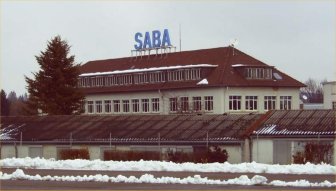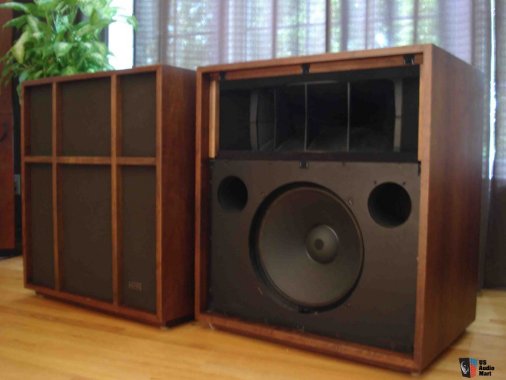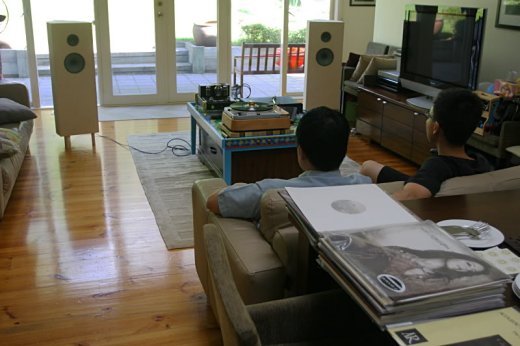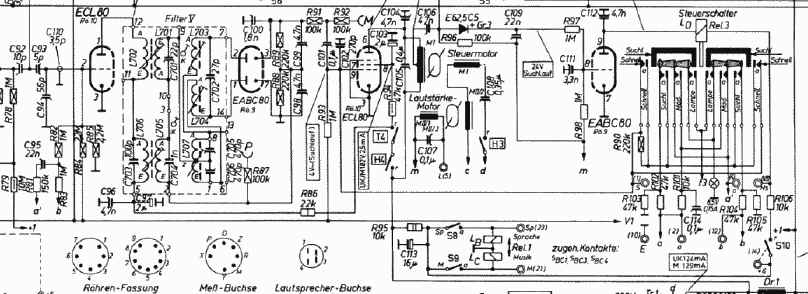Vollautomatic 12 Stereo


The company was founded back in 1835 by Joseph Benedikt under the name of Jockele-Uhren. Only in 1923, with the production of components for radio devices, the company went under the name of SABA.
At the end of the 1920s SABA became extremely popular with the well-known S35 and in the following year the brand became the second biggest German producer after Telefunken.
During the war SABA was producing machinery for the army and in 1945 the company was completely destroyed by a bombing.
In 1947 SABA began the production of radios again distinguishing itself for avant-garde, high quality production.

Alnico Greencone Loudspeakers became popular for their feautures of linearity, tenuta in potenza, constant impendance and they were employed by many other producers in all HI-FI devices at that time.
Motorized tuning devices became popular as well and SABA became the German brand synonym of quality, reliability and extreme precision.
In the 1970s the brand began to decline because at that time only Japanese devices were thought to have HI-FI. In the 1980s Thomson bought out SABA.
In the 1990s, the other way around, having a 1970s Japanese device meant no HI-FI. They also found out that those devices worked with a 96% negative feedback and that a device with a 0,001 db from 1 to 100 KHz does not necessarily work well.
We do not trust completely our ears but we do trust what other people say, not necessarily with good intentions. In 2007, due to insolvency, SABA disappeared from the French(Thomson)-Chinese(TCL) venture and ceased to exist.

Images
apart, this web page is similar to the Saba Freiburg 14 page except that
this model is equipped without the stereo decoder.
I started the description of the Saba Freiburg 100 with this sentence:
going beyond one’s self is the destiny of the greatest. And the story
goes on. The Saba Freiburg 12 is the evolution of Freiburg 100, 125, 11.
The Freiburg 12 is the first model equipped with Push-Pull output stage
in both the channels.
Saba, following the German tradition, continued to use the name Freiburg for its top models, even though the latter did not have anything in common with the original masterwork.
I want to highlight the fact that this was the top model of the most prestigious german brand in the golden age of german technology and production.
As I have mentioned before, the first visual impact is shocking and exciting. This is a huge device successfully showing off its majesty.
The sound
impact is even stronger and more exciting. But before that, I would like
to present a brief description of one of the most distinguishing feature
of this device: the loudspeaker system.

The loudspeaker ensemble is composed of two 250 mm (9.9 inches) woofers, two 200 mm (7.8 inches) wideband and an elliptical tweeter.
The radiant
area of the loudspeaker group is the same as the Altec Valencia (see picture),
medium-high included.
Not bad at all for a “radio device.”
All the loudspeakers are the amazing Greencone that are still today employed on highly appreciated Hi-End speakers. This device has more and better loudspeakers than the majority of later HI-FI systems.
Greencones are very fast if compared to other contemporaneous loudspeakers and for this reason they reproduce a modern and extremely clear sound. Moreover, the particular cone treatment ensures a low humidity sensitivity. This help the maintenance of good conditions over the years.


Free air response of one of a 8" mid/woofer used in this device.
Fonte: www.troelsgravesen.dk
Due to their high efficiency, these loudpseakers are suitable for low- power valves amplifiers. Basses are remarkable thanks to the two 240 mm (9.7 inches) woofers. Mediums are clear thanks to the two 200 mm (7.8 inches) wideband and the acutes are sharp thanks to the front elliptical tweeter.
When
you are listening to spoken radio programs, the best effect could be obtained
by leaving the device on “Sprache”.
Another exclusive feature is the automatic tuning. By pushing one of the
buttons beneath the main keyboard you can notice that the needle automatically
moves to another station following the direction of the pushed button,
either right- or leftward.
The volume
knob is a tad hard to turn because it has to pull the engine connected
to the potentiometer.
This device was indeed equipped with a flush remote control through which
it was possible to regulate the volume by pushing two buttons. The latter
made the engine turn.
Other details will be further analyzed.
On this page I showed
the FM stage calibration process of this device.
The Freiburg is best to be listened in on a medium-big room.
This queen radio was destined and thought for a upper middle-class
audience due to its expensive initial price. The large amount of time
necessary for its restoration makes of it an expensive device still today.











Superheterodyne IF: 468/10700 kHz
10
AM Circuits
13 FM Circuits
Wavebands:
Medium Waves (OM)
Long Waves (OL)
Short waves (OC)
FM (UKW)
5
Greencone loudspeakers:
2 x 10" Alnico woofers
2 x 8" Alnico mid/woofers
1 Elliptical tweeter
Dimensions
(LHD):
27,6 x 17.9 x 12.2 inch
Net weight: 53.6 lb
14
Tubes:
EC92 EC92 ECH81 EF89 EM87 EBF89 EF86 EF86 ECC83 ELL80 ELL80 EM84 EABC80
ECL80
Ferrite rotating aerial
Automatic tuning research
Optional remote control

TONE CONTROL WITH LEVEL INDICATION
The tone control system is really efficient. Above the tone control knob you can find a small window that progressively lights up indicating the emphasis given to the band.






The correction
system of the frequency response is composed of two buttons, MUSIK and
SPRACHE.
They allow the emphasis of high and low tones while listening to music
and of medium tones while listening to spoken programs.
A light indicates the selected choice




AERIAL ORIENTATION
Rotating
ferrite curve with lightened window indicating its position.
The ferrite curve can be rotated through a big knob which is coaxial to
the volume knob. Inside the
piece of furniture there is a dipole for the FM reception and a directable
ferrite curve for the AM
reception.



AM AND FM SEPARATED TUNING CONTROL
The device
is equipped with separated tuning mechanisms for AM and FM bands and for
each of the FM bands.
There is only one tuning knob but the selector changes on a cable and
pulley system that are separated according to the band.
Worth noticing is the accuracy and the complexity of the motorized FM
group.

AUTOMATIC MOTORIZED TUNING
The
tuning system is a masterwork.
It is a motor with windings supplied in a phase shifted by some capacitors.
It permit to change the motor rotation direction of according to whether
the search is in one sense or another.
The tuning is centered by drawing part of the signal from the
CAC circuit and by using a relais controlled by a tube.
As already mentioned, calibration is rather complex and it cannot be put
into practice without referring to SABA’s original manuals.
Below a detail of the engine and the scheme section to control the automatism.


VOLUME CONTROL
Another
interesting feature is the volume control.
The knob does not automatically control the volume potentiometer. It controls
through an unknot push-back.
The motorized remote control has a slight friction effect which strengthens
the resistance when you turn the knob.

REMOTE CONTROL
Another
exclusive feature is the possibility to insert the plug (see picture)
in the designated back
socket and remotely control the volume and tuning.
Archive material

MONO/STEREO SWITCH
Mono/stereo
commutator does have its lightened indicators as well.
Usuallu the stereo position work only when you are listening to CDs
or IPODs, but this model is equipped with a stereo decoder allowing an
accurate stereophony FM reception.



CONTROLS
The first
small window that can be seen on the left side indicates whether the ferrite
curve is inserted and its position.
On the left side you can also find the volume control (with incorporated
loudness) and the ferrite curve rotation control.
Right above the volume control there is a magic eye indicating the perfect
tuning of each station.
Below you can see the Mono/Stereo indicator and further below the bass
control knob.
The
AM bands with Short, Medium and Long Waves and the FM displays.
Starting from the lefthand corner you can see the Musik/Sprache, Stereo/Mono,
AUX input buttons, the band switch buttons, the Long, medium, short waves
and FM switch buttons and the motorized tuning system (Automatik) button.
Lastly
the ON button.
Next to it the acutes control knob is to be found.
The Musik/Sprache equalizer indicator.
On the right, the tuning knob, which is supported by a big fly-wheel that
renders its movement really pleasant.
The automatic tuning functioning indicator is to be found on the right
as well.
Above the stereo modulation indicator and below two buttons for the automatic
tuning functioning. Each button activates the automatic tuning mechanism
in one or the other direction. By pushing one of those buttons the engine
constantly activates the tuning indicator for a fast reposition.

LOUDSPEAKERS
Loudspeakers
are another remarkable feature of this device: the well-know Alnico Greencone.
Its side wideband create a three-dimensional effect.
The topic has been largely researched before the advent of stereophonics
and quadrophonics.
The sound is amazing


REAR SIDE
Output
for external speakers. Socket for recorder (tonbandgerat). Turntable input
(Tonabnehmer)
AM and FM aerial inputs and ground socket. Remote control inputs












CONTACTS
ITALIA
& Technical, Info
Email: Giovanni
- Cell: +39.331.6016062
INTERNATIONAL
Business
public relations Asia - Australia - Email:
Giuliana
Business
public relations Europe - America - Email:
Lisa
- Ph +1 937 825 0433 Ohio
- USA
- SH399 - Radio a valvole - Tube radios - Vacuum tubes - Röhrenradios - HH384 -